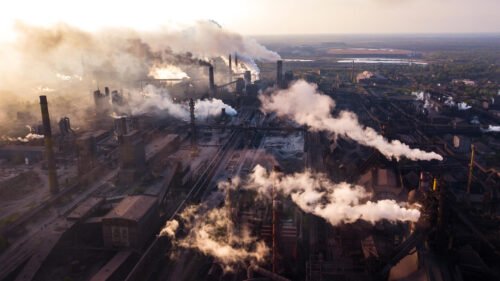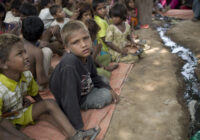Pakistan is highly exposed to climate change due to its terrain, its weather patterns and its weak infrastructure. Arguably the worst in its history, the 2022 floods submerged a third of the country, affected 33 million people, resulted in 1,700 deaths and caused $30 billion in damages and economic losses, according to the World Bank.
Thanks to the government’s failures, Pakistan has sharply climbed up the ladder vis-à-vis weather extremes. It ranked #5 among countries most affected by extreme climatic events in GermanWatch’s Climate Risk Index 2020. The country now tops the list, mainly due to its monsoon-driven, exceptionally high relative economic losses between June and September 2022.
The increased chances of natural catastrophes have proven lethal. Climate-related calamities have triggered 802 fatalities this year, including 203 children, in the ongoing rainy season. Much of the damage and deaths took place in Khyber Pakhtunkhwa (KP), and the bad weather wreaked havoc on infrastructure, crops and livestock.
One of the main reasons for the increase in climate-related catastrophes is due to a phenomenon called glacial melt. Over a period of many years, glacial melt led to the creation of thousands of glacial lakes in northern areas. The process, kindled by excessive heat, sharply elevated the specter of glacial lake outburst floods (GLOFs). These sudden events — which are able to cause significant downstream damage by releasing millions of cubic meters of water and debris in a few hours — are a persistent threat to life, infrastructure and livelihoods of 7 million people in KP and Gilgit-Baltistan.
Governance weaknesses
Pakistan’s government often singles out climate injustice and “lopsided allocation” — receiving $2.8 billion from international creditors against pledges of $10 billion — of green funding for its failure on climate action. Yet it remains unwilling to address its own governance weaknesses and step up climate adaptation efforts.
For instance, the UN-backed $37 million GLOF-II project faced criticism for failing to contribute to disaster preparedness and deliver early warnings, partially because the funds were allegedly misused. Other projects were also accused of being plagued by institutional incompetence and corruption, or of eroding in value due to unimpeded deforestation.
Similarly, poor access to climate-smart technologies for farmers and major policy distortions, such as in wheat procurement and inequitable subsidies, continue to block Pakistan’s agricultural transformation and harm rural communities.
Climate finance gaps
At the international climate conference known as COP27, the loss and damage fund was hailed as a quantum leap in climate finance, but as of this past June, 27 countries had pledged just $789 million — a minuscule fraction of the hundreds of billions required annually.
Developed nations, largely responsible for global emissions, have shaped the climate fate of vulnerable countries like Pakistan. Their industrialization has created an existential crisis for nations that have made minimal contributions to the problem. Pakistan’s government must act decisively and not succumb to inaction to prevent an irreversible climate catastrophe.
The situation demands an immediate response. Pakistan faces severe climate impacts, including heatwaves, droughts, floods and glacial melt that have disproportionately affected marginalized communities and jeopardized development.
To avert disaster, the government must address deep-seated governance issues like uncoordinated policy, insufficient resources, corruption and poor implementation of climate strategies. This includes strengthening institutions, ensuring transparency and fostering participatory decision-making with local communities, civil society and experts. Without strong governance, climate efforts will fail. The time for action is now.
Mobilizing domestic resources
For Pakistan to imprint a sustainable impact on climate change, it shouldn’t rely squarely on international climate financing and must mobilize domestic resources. Rather than merely shifting blame to the wealthy nations, it should expand the network of technology providers (largely concentrated in Punjab) across Pakistan and encourage private investment in renewable energy and climate-resilient infrastructure to boost productivity and lower emissions.
Establishing effective risk-sharing mechanisms, such as crop insurance, promoting initiatives like the issuance of green bonds and experimenting with alternative climate finance models, for example, debt-for-climate swaps, should be expedited to protect farmers and generate climate finance.
The country’s energy mix is highly dominated by oil, gas and coal. Albeit shrinking, circular debt in the energy sector is both a threat to climate adaptation and economic stability, butting heads with terrorism and insurgency for the country’s biggest challenge.
Considering Pakistan’s economic fragility and limited foreign exchange reserves, its heavy reliance on fossil fuels could be acceptable only as a short-term necessity to facilitate a transition toward long-term climate resilience.
Still, the government can’t lurk behind climate injustice to evade climate action. This will be akin to courting disaster. Fixing systemic inefficiencies such as a low tax-to-GDP ratio, strengthening accountability mechanisms and controlling transmission and distribution losses and unproductive subsidy regimes could create a fiscal space to shore up Pakistan’s climate resilience.
The need for a non-partisan response
In the coming decades, Pakistan is projected to remain among the most vulnerable countries to climate change and extreme weather. The country’s high exposure to torrential downpour, floods, cloudbursts and GLOFs urges a collective, nonpartisan national response.
By lacing up climate action with climate injustice or resorting to cosmetic measures — viewed by experts as taxation levies framed as climate mitigation efforts, while climate adaptation funding has declined from 40% to 10% in a decade — the government shouldn’t pretend to act.
The monsoon that once whispered of bliss and euphoria now brings pain and affliction. What was rejoiced as a boon is being mourned as a doom. Climate change isn’t alone responsible for this tragic reversal. Chronic Governance failures have also magnified this crisis. Addressing systemic weaknesses is crucial to boost climate adaptation and build a climate-resilient Pakistan.
[Patrick Bodovitz edited this piece.]
The views expressed in this article are the author’s own and do not necessarily reflect Fair Observer’s editorial policy.
Support Fair Observer
We rely on your support for our independence, diversity and quality.
For more than 10 years, Fair Observer has been free, fair and independent. No billionaire owns us, no advertisers control us. We are a reader-supported nonprofit. Unlike many other publications, we keep our content free for readers regardless of where they live or whether they can afford to pay. We have no paywalls and no ads.
In the post-truth era of fake news, echo chambers and filter bubbles, we publish a plurality of perspectives from around the world. Anyone can publish with us, but everyone goes through a rigorous editorial process. So, you get fact-checked, well-reasoned content instead of noise.
We publish 3,000+ voices from 90+ countries. We also conduct education and training programs
on subjects ranging from digital media and journalism to writing and critical thinking. This
doesn’t come cheap. Servers, editors, trainers and web developers cost
money.
Please consider supporting us on a regular basis as a recurring donor or a
sustaining member.
Will you support FO’s journalism?
We rely on your support for our independence, diversity and quality.












Comment